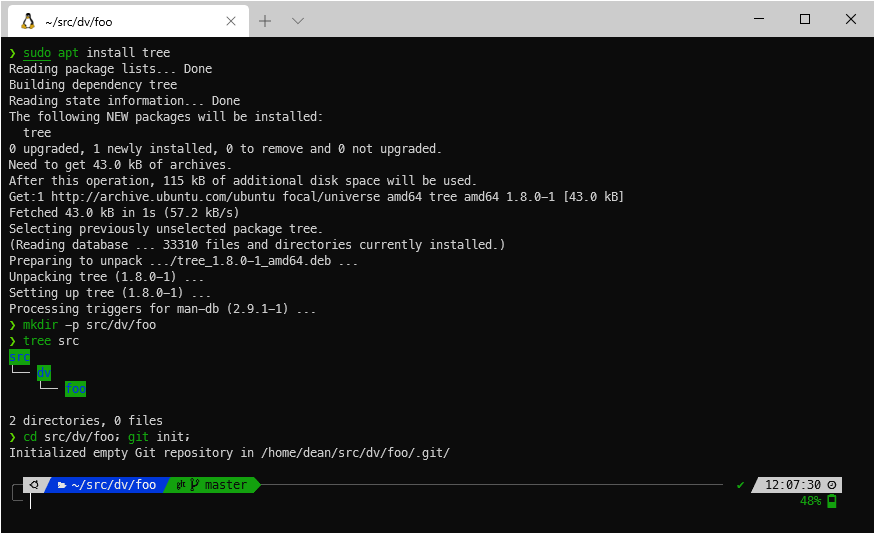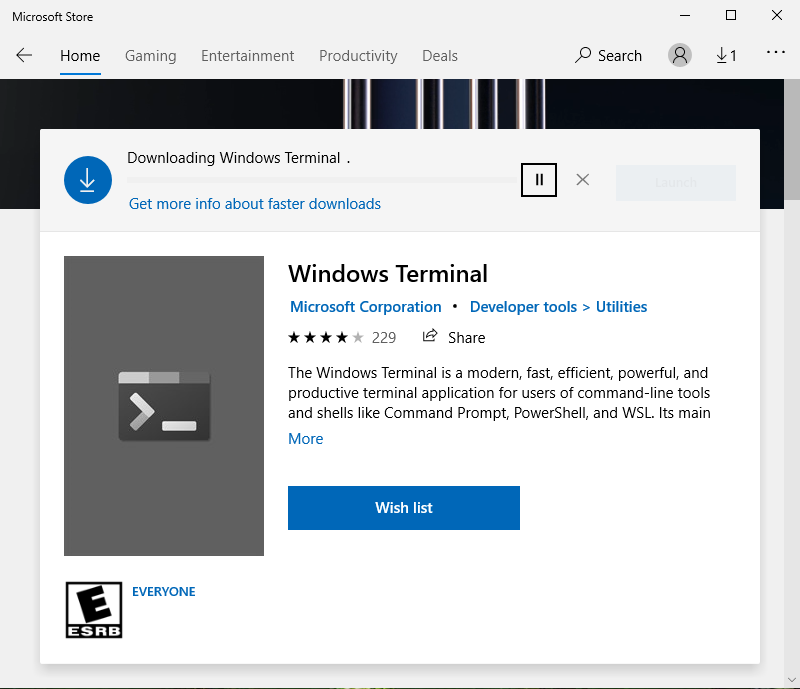WSL with Oh My Zsh and P10k
WSL is the best way to work on Windows.

Follow along to setup WSL and Z shell, an alternative to bash with awesome plugin & theme support. This setup uses the popular Oh My Zsh Zsh configuration framework to manage Zsh plugins and themes (it comes bundled with helpers & aliases as well). As for the theme, we use the impressive, Powerlevel10k seen in the screenshot above.
You can find this tutorial and referenced files on github at deanbot/easy-wsl-oh-my-zsh-p10k.
Table of contents
- WSL and Ubuntu
- VS Code
- Windows Terminal
- Zsh and Oh My Zsh
- Powerlevel10k
- Install Zsh plugins
- Next steps
- Revert to bash
WSL and Ubuntu
First let’s set about installing WSL and the latest LTS of Ubuntu.
Enable features for WSL and WSL 2
- Run Windows PowerShell as administrator
- Install WSL via:
dism.exe /online /enable-feature /featurename:Microsoft-Windows-Subsystem-Linux /all /norestart
Microsoft note: “WSL 2 is only available in Windows 10, Version 2004, Build 19041 or higher. You may need to update your Windows version.”
To upgrade to WSL 2:
- Enable the required feature via:
dism.exe /online /enable-feature /featurename:VirtualMachinePlatform /all /norestart - Restart your machine.
- Download and install the WSL 2 Linux kernel update.
- Open Windows PowerShell and run the command:
wsl --set-default-version 2
Install Ubuntu
To install the latest Ubuntu LTS version (i.e. 20.04):
-
Open Windows Store and search for Ubuntu (quick link). Select Ubuntu (note you can verify the Ubuntu version by selecting More) and then select Install.

-
Launch Ubuntu to complete installation.
-
Create a user account by entering a User Name, i.e. your first name (typically lowercase) and a password.
See also: Change or recover your password
-
Update packages enter:
sudo apt update && sudo apt upgradeNote you may need to right click or
ctrl+shift+vto paste.Press
[enter]to selectYat the prompt to install any package updates.
We’ll switch to Windows Terminal in a following step, as the default WSL/Ubuntu terminal emulator is not the greatest.
VS Code
If you’re a VS Code user, some light setup is required for proper WSL use.
After installing WSL, launch VS Code. It should prompt you to install Remote - WSL. Alternatively, install the Remote Development extension pack which bundles a few related extensions.
See also: VS Code: Developing in WSL
Windows Terminal
I highly recommend installing Windows Terminal. The most compelling reason might be how easy it is to launch different shells be they PowerShell, WSL, git bash, or command prompt… but it can split/resize/move between panes really well too.
Install Windows Terminal
To install Windows Terminal, open Windows Store. Search for and install Windows Terminal. I suggest pinning Windows Terminal to your start menu or taskbar.

Update default profile
The default profile shown when you launch Windows Terminal is Windows PowerShell. Selecting the dropdown reveals Ubuntu.
To change the default profile:
- Enter
ctrl+,to open the settings file for Windows Terminal in you default editor. - Locate the
guidfor WSL/Ubuntu and then copy and paste this value in thedefaultProfileproperty.


Configure Windows Terminal
Note: See settings.json for reference.
-
Include the following settings for
profiles.defaults:"defaults": { // Put settings here that you want to apply to all profiles. // "fontFace": "MesloLGS NF", "fontSize": 9, "snapOnInput": true, "historySize": 9001, "acrylicOpacity": 0.85, "useAcrylic": true, "closeOnExit": true },Leave fontFace commented until you install the font in a following section.
-
Hide irrelevant profiles by setting the
hiddenproperty totrue. -
To start in linux home instead of windows user profile directory, add
"startingDirectory"property to the Ubuntu profile and set it to"//wsl$/Ubuntu/home/<username>", replacing ‘Ubuntu’ with the name of the distribution you installed and and ‘’ with your Ubuntu username, i.e. if you installed ‘Ubuntu 20.0.4 LTS’, use "startingDirectory": "//wsl$/Ubuntu-20.0.4/home/<username>".
Zsh and Oh My Zsh
Next, we’ll install Zsh and Oh My Zsh.
Install and setup Zsh
To install Z shell and set it as your default shell run:
sudo apt install zsh
chsh -s /bin/zshLog out and login back again to use your new default shell.
If you have no .zsh[...] files in your home directory you will be prompted. Feel free to run through the configuration wizard however this will get replaced by Oh My Zsh. I recommend selecting 2 at the prompt to create a .zshrc with defaults.

Install Oh My Zsh
To install Oh My Zsh run:
sh -c "$(curl -fsSL https://raw.github.com/ohmyzsh/ohmyzsh/master/tools/install.sh)"
If you had a .zshrc file it’s now backed up as .zshrc.pre-oh-my-zsh and replaced with a new configuration file which loads Oh My Zsh.
Powerlevel10k
Next, we’ll install the Powerlevel10k Zsh theme. The recommended font for p10k works well in Windows Terminal.
Install fonts
First, manually install the recommended Meslo Nerd Font (patched for p10k) - found here.
To install, download and double-click each variation and select install.
Note: If using Windows Terminal, enable the font by adding "fontFace": "MesloLGS NF" to profile.defaults or the WSL profile.
Install theme
To install p10k:
- Run:
git clone --depth=1 https://github.com/romkatv/powerlevel10k.git ${ZSH_CUSTOM:-~/.oh-my-zsh/custom}/themes/powerlevel10k - Set
ZSH_THEME="powerlevel10k/powerlevel10k"in~/.zshrc.
Run configuration wizard
Restart your shell by logging out logging back in. The configuration wizard should start automatically, otherwise run p10k configure.

Follow prompts to configure p10k to your liking. First, it prompt you to verify whether you see given icons. Afterwards, you’ll be prompted for ui preferences. These are up to you. The following choices work well but go crazy.
- Prompt Style: Rainbow
- Character Set: Unicode
- Show Current Time: 24-hour format
- Prompt Separators: Slanted
- Prompt Heads: Sharp
- Prompt Tails: Flat
- Prompt Height: Two Lines
- Prompt Connection: Solid
- Prompt Frame: Left
- Connection & Frame Color: Dark
- Prompt Spacing: Sparse
- Icons: Many Icons
- Prompt Flow: Concise
- Enable Transient Prompts: yes
- Instant Prompt Mode: Verbose
If you don’t like what you came up with restart or remove your .p10k.zsh file.
Note: see p10k.zsh for reference.
The configuration I’m using at any given time is found in my deanbot/dotfiles repo.
Enable battery indicator
- Edit
.p10k.zsh - Uncomment the
battery # internal batterline in the list ofPOWERLEVEL9K_RIGHT_PROMPT_ELEMENTSand save. - Run:
source ~/.p10k.zshto see changes.
Install Zsh Plugins
Most plugins are installed automatically with Oh My Zsh by editting plugins in .zshrc.
The following suggested plugins have minimal installation steps:
- zsh-autosuggestions - fish shell style autosuggestion based on history and completions.
- zsh-syntax-highlighting - color coding in the terminal to let you know if a command you’re about to enter is valid.
To install zsh-autosuggestion and zsh-syntax-highlighting:
- Run the following commands one at a time:
git clone https://github.com/zsh-users/zsh-autosuggestions.git $ZSH_CUSTOM/plugins/zsh-autosuggestions
git clone https://github.com/zsh-users/zsh-syntax-highlighting.git $ZSH_CUSTOM/plugins/zsh-syntax-highlighting-
Permissions on these two plugins may be too permissive (you’ll be warned by zsh the next time you log into your shell). To correct this run:
cd $ZSH_CUSTOM/plugins/ sudo chmod 755 ./zsh* cd ~ -
Edit
.zshrcvia your preferred editor be it nano, micro, VSCode, etc (i.e. for VSCodecode ~/.zshrc). -
update the
pluginsline to:plugins=(git z zsh-autosuggestions zsh-syntax-highlighting)and save.

Next steps
Where to go from here? Some suggestions in no particular order:
- Review/adjust Windows Terminal keybindings.
- Extend dot files with your desired aliases or path modifications.
- Familiarize yourself with Zsh and browse tips & tricks from the community.
- View the Oh My Zsh cheatsheet.
- Explore the Oh My Zsh plugins directory.
- Customize p10k.
Revert to Bash
So you want to cut and run aye? Returning to a bash shell is easily done:
- Uninstall Oh My Zsh (ref):
uninstall_oh_my_zsh - Set default shell to bash:
chsh -s $(which bash)